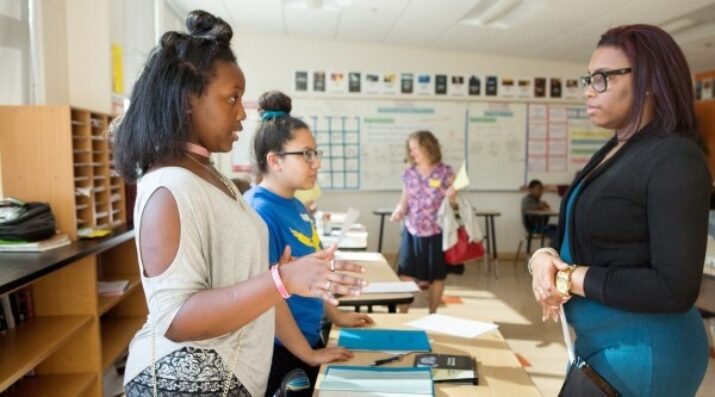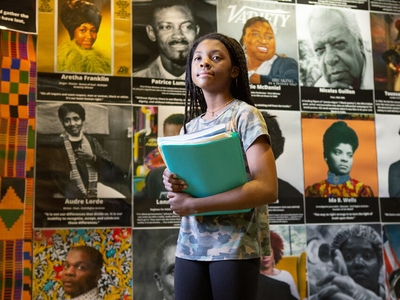Designing for Equity
Equitable and Sustainable Social-Emotional Learning: Embracing Flexibility for Diverse Learners
Topics

Together, educators are doing the reimagining and reinvention work necessary to make true educational equity possible. Student-centered learning advances equity when it values social and emotional growth alongside academic achievement, takes a cultural lens on strengths and competencies, and equips students with the power and skills to address injustice in their schools and communities.
Four social-emotional learning interventions that foster flexibility and relevance can be used to effectively meet the diverse needs of learners.
In the realm of education, conversations surrounding social-emotional learning (SEL) often highlight its transformative potential for students. However, as an advocate for student-centered approaches and equitable practices, I believe it's essential to address the complexities and nuances of implementing effective SEL interventions. My journey in education has been shaped by insightful interactions and reflective moments, one of which occurred during a conversation with a fellow educator.
I vividly recall the day when an educator approached me in a flurry, exclaiming, "Oh, you're working with this student? Thank goodness because she needs to get it together and stop being so extra." While I empathized with the educator's sense of overwhelm due to the student's frequent behavioral challenges, the comment reflected a common misconception about SEL. It framed the student as a project in need of rescue, rather than acknowledging the broader purpose of SEL—equipping individuals with essential social and emotional skills.
In response, I sought to bridge this misconception through psychoeducation, emphasizing, "The work that I am doing isn't about changing her behavior overnight but providing her with tools to develop social and emotional skills, which are vital for everyone."
However, my experience with this student revealed an important lesson for me as well: not all SEL interventions resonate universally. Despite diligently learning various techniques, the student's behavior remained unchanged. Why? The key reason was that these techniques did not fully connect with her. Memorizing affirmations, breathing strategies, or meditation poses did not align with her understanding of emotional regulation.
This encounter, among others throughout my five plus years in education, highlighted the need to abandon the one-size-fits-all approach to SEL. Instead, we must shift away from viewing SEL as a remedy solely for "problematic" students and embrace it as a universal need for everyone, regardless of age or background.
Embracing Flexibility in SEL
Social-emotional learning initiatives must be adaptable and inclusive to effectively meet the diverse needs of learners. Let's delve deeper into four interventions aimed at fostering flexibility and relevance within SEL programs:
Student-Led Assemblies
Empowering students to lead assemblies provides a platform for authentic self-expression and leadership development. During these assemblies, students can showcase talents such as music, dance, or spoken word that resonate with their cultural backgrounds. This approach not only boosts confidence but also encourages peer support and understanding, promoting empathy and celebrating diversity within the school community.
Restorative Circles
Restorative circles offer a structured space for students to engage in meaningful dialogue, resolve conflicts, and build positive relationships. Often led by students, these circles promote restorative justice principles by emphasizing accountability, empathy, and collective problem-solving. By incorporating cultural values and perspectives into these circles, students gain a deeper understanding of community dynamics and learn to navigate conflicts with cultural sensitivity and mutual respect.
Culturally Relevant Curriculum
Interest-based learning involves actively seeking students' input on topics that interest them and integrating culturally relevant content into the curriculum. This approach fosters engagement and relevance by connecting academic concepts to students' lived experiences and cultural identities. For instance, students might explore historical events, traditions, or artistic expressions from their communities, deepening their understanding of themselves and others while building critical thinking skills.
Take-Home Resources
Providing SEL resources that students can access outside of school extends learning beyond the classroom and into students' daily lives. Take-home resources may include activity packets, guided reflections, or recommended readings related to emotional regulation, mindfulness, or interpersonal skills. By encouraging students to engage with SEL concepts outside of formal instruction, educators support continuous growth and self-discovery in environments where students feel empowered to explore and express themselves authentically.
Empowering Students to Navigate Challenges
By embracing flexibility in social-emotional learning, educators can create dynamic and inclusive environments that prioritize student voices and cultural relevance. Interventions like the four listed above not only support academic achievement but also nurture holistic well-being by empowering students to navigate challenges with resilience, empathy, and self-awareness. As we continue to evolve our approach to SEL in K-12 education, let us remain committed to fostering environments where every learner feels valued, understood, and equipped to thrive in diverse and interconnected communities.
Photo at top by Allison Shelley/The Verbatim Agency for EDUimages, CC BY-NC 4.0: An eighth grader presents her solutions for solving a human rights problem in the United States.




